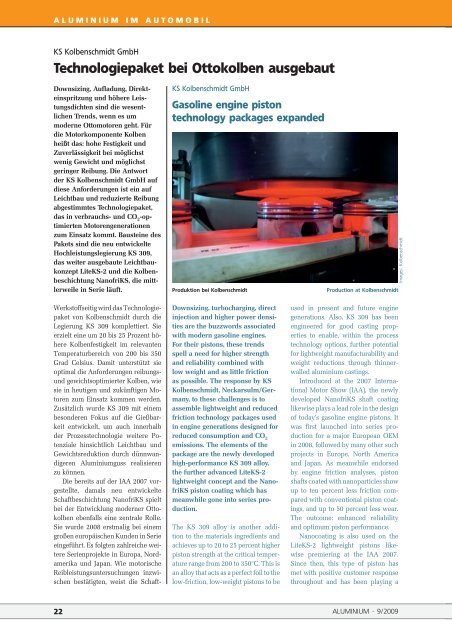special - Alu-web.de
special - Alu-web.de
special - Alu-web.de
Create successful ePaper yourself
Turn your PDF publications into a flip-book with our unique Google optimized e-Paper software.
A L U M I N I U M I M A U t o M o b I L<br />
KS Kolbenschmidt GmbH<br />
technologiepaket bei ottokolben ausgebaut<br />
Downsizing, Aufladung, Direkteinspritzung<br />
und höhere Leistungsdichten<br />
sind die wesentlichen<br />
Trends, wenn es um<br />
mo<strong>de</strong>rne Ottomotoren geht. Für<br />
die Motorkomponente Kolben<br />
heißt das: hohe Festigkeit und<br />
Zuverlässigkeit bei möglichst<br />
wenig Gewicht und möglichst<br />
geringer Reibung. Die Antwort<br />
<strong>de</strong>r KS Kolbenschmidt GmbH auf<br />
diese Anfor<strong>de</strong>rungen ist ein auf<br />
Leichtbau und reduzierte Reibung<br />
abgestimmtes Technologiepaket,<br />
das in verbrauchs- und CO 2 -optimierten<br />
Motorengenerationen<br />
zum Einsatz kommt. Bausteine <strong>de</strong>s<br />
Pakets sind die neu entwickelte<br />
Hochleistungslegierung KS 309,<br />
das weiter ausgebaute Leichtbaukonzept<br />
LiteKS-2 und die Kolbenbeschichtung<br />
NanofriKS, die mittlerweile<br />
in Serie läuft.<br />
Werkstoffseitig wird das Technologiepaket<br />
von Kolbenschmidt durch die<br />
Legierung KS 309 komplettiert. Sie<br />
erzielt eine um 20 bis 25 Prozent höhere<br />
Kolbenfestigkeit im relevanten<br />
Temperaturbereich von 200 bis 350<br />
Grad Celsius. Damit unterstützt sie<br />
optimal die Anfor<strong>de</strong>rungen reibungs-<br />
und gewichtsoptimierter Kolben, wie<br />
sie in heutigen und zukünftigen Motoren<br />
zum Einsatz kommen wer<strong>de</strong>n.<br />
Zusätzlich wur<strong>de</strong> KS 309 mit einem<br />
beson<strong>de</strong>ren Fokus auf die Gießbarkeit<br />
entwickelt, um auch innerhalb<br />
<strong>de</strong>r Prozesstechnologie weitere Potenziale<br />
hinsichtlich Leichtbau und<br />
Gewichtsreduktion durch dünnwandigeren<br />
<strong>Alu</strong>miniumguss realisieren<br />
zu können.<br />
Die bereits auf <strong>de</strong>r IAA 2007 vorgestellte,<br />
damals neu entwickelte<br />
Schaftbeschichtung NanofriKS spielt<br />
bei <strong>de</strong>r Entwicklung mo<strong>de</strong>rner Ottokolben<br />
ebenfalls eine zentrale Rolle.<br />
Sie wur<strong>de</strong> 2008 erstmalig bei einem<br />
großen europäischen Kun<strong>de</strong>n in Serie<br />
eingeführt. Es folgten zahlreiche weitere<br />
Serienprojekte in Europa, Nordamerika<br />
und Japan. Wie motorische<br />
Reibleistungsuntersuchungen inzwischen<br />
bestätigten, weist die Schaft-<br />
KS Kolbenschmidt GmbH<br />
Gasoline engine piston<br />
technology packages expan<strong>de</strong>d<br />
Produktion bei Kolbenschmidt Production at Kolbenschmidt<br />
Downsizing, turbocharging, direct<br />
injection and higher power <strong>de</strong>nsities<br />
are the buzzwords associated<br />
with mo<strong>de</strong>rn gasoline engines.<br />
For their pistons, these trends<br />
spell a need for higher strength<br />
and reliability combined with<br />
low weight and as little friction<br />
as possible. The response by KS<br />
Kolbenschmidt, Neckarsulm/Germany,<br />
to these challenges is to<br />
assemble lightweight and reduced<br />
friction technology packages used<br />
in engine generations <strong>de</strong>signed for<br />
reduced consumption and CO 2<br />
emissions. The elements of the<br />
package are the newly <strong>de</strong>veloped<br />
high-performance KS 309 alloy,<br />
the further advanced LiteKS-2<br />
lightweight concept and the NanofriKS<br />
piston coating which has<br />
meanwhile gone into series production.<br />
The KS 309 alloy is another addition<br />
to the materials ingredients and<br />
achieves up to 20 to 25 percent higher<br />
piston strength at the critical temperature<br />
range from 200 to 350°C. This is<br />
an alloy that acts as a perfect foil to the<br />
low-friction, low-weight pistons to be<br />
used in present and future engine<br />
generations. Also, KS 309 has been<br />
engineered for good casting properties<br />
to enable, within the process<br />
technology options, further potential<br />
for lightweight manufacturability and<br />
weight reductions through thinnerwalled<br />
aluminium castings.<br />
Introduced at the 2007 International<br />
Motor Show (IAA), the newly<br />
<strong>de</strong>veloped NanofriKS shaft coating<br />
likewise plays a lead role in the <strong>de</strong>sign<br />
of today’s gasoline engine pistons. It<br />
was first launched into series production<br />
for a major European OEM<br />
in 2008, followed by many other such<br />
projects in Europe, North America<br />
and Japan. As meanwhile endorsed<br />
by engine friction analyses, piston<br />
shafts coated with nanoparticles show<br />
up to ten percent less friction compared<br />
with conventional piston coatings,<br />
and up to 50 percent less wear.<br />
The outcome: enhanced reliability<br />
and optimum piston performance.<br />
Nanocoating is also used on the<br />
LiteKS-2 lightweight pistons likewise<br />
premiering at the IAA 2007.<br />
Since then, this type of piston has<br />
met with positive customer response<br />
throughout and has been playing a<br />
22 ALUMINIUM · 9/2009<br />
Images: Kolbenschmidt
















